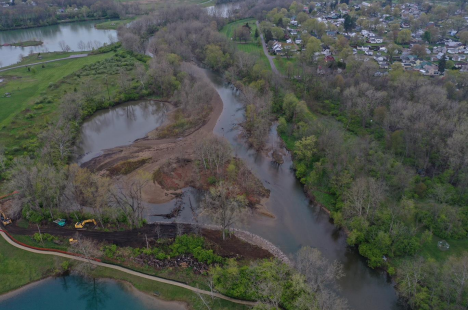MOUNT VERNON – Mount Vernon completed three phases of its Kokosing River Restoration project, but City Engineer Brian Ball said the city isn’t done working to improve its condition within city limits.
The river is a state and national scenic river. Outside city limits, it scores high on water quality, the habitat, shape of the river and its banks, and the riparian and tree corridors by state agencies including the Ohio Department of Natural Resources Fish and Wildlife and the Ohio Environmental Protection Agency, he said.
Historic in-channel gravel mining and back-of-bank mining helped create the issues. The berms aren't levees. Instead they are spoils from the gravel pit pushed up against the river, Ball said.
The city has seen significant bank erosion in the past 20 years.
“That erosion is happening in mining areas where they gravel mined. We're losing a lot of soil. Soil also has phosphorus in it that's contributing to downstream problems,” he said.
Erosion caused trees to fall into the river and that raises the water temperature. The result is less oxygen in the water, and fish and other aquatic life suffers.
The city began its projects in 2016 and identified three areas in the Armstrong Run watershed at West Lake, Norton Street and Phillips Drive with degraded habitat and active erosion along the Kokosing River, the city said. The restoration projects began for habitat improvement and river bank stability in March by Environmental Remediation Contractor and Tuscon Inc. The work was completed in June.
The city’s storm water utility contributed the local match for a $300,000 Ohio EPA grant and a $200,000 Muskingum Watershed Conservancy District grant to fund the projects.
West Lake was given a reinforced raised bank of limestone rock material to allow river and lake waters to intermingle, reducing the risk of a breach or washout. Protective, native vegetation was reestablished along the rebuilt, tiered riverbank along Norton Street and East Lake. Cross-vane featured installed along the Phillips Driver riparian corridor help direct river flow away from the bank to the river’s center to minimize erosion and protect the vegetation.
With the completed restoration projects, Mount Vernon has three big areas stabilized where Ball said they hope to see an increase in habitat. City staff met with fisheries specialists at Ohio State University to discuss having them involved in monitoring how effective the restoration has been and if the habitat improves.
The projects stopped a lot of sediment and soil going down the river, which Ball said was evident in recent high water events.
Future projects probably will include doing more habitat work on the lake side of the Kokosing. For West Lake, stabilization was accomplished. The gravel pit berm was lowered. But no planting was involved.
“We didn't get any of the trees sort of reestablished. So that will be a big project we'll be working with our Shade Tree and Beautification Commission to get out there, probably next calendar year, and get some trees planted in that area,” Ball said.
The Middle Lake has a lot of bush honeysuckle that prevents young trees from growing.
“They consider it a non-native borderline invasive plant, so we're trying to work on getting more of that taken out and replacing it with some young trees,” he said.
This project is part of a sub-watershed master plan that the DNR helped the city get started in 2016. Two other sub-watershed master plans kicked off. One for Dry Creek is in the section of river just downstream of the Main Street Bridge. The Centerline is a combined watershed masterplan and will include projects in both areas. Along Memorial Park, quite a bit of erosion occurs, along with other issues the Engineering Department will examine.
They also will look at flooding issues on Center Run, which comes across Coshocton Avenue in the business shopping district.
“There's some flooding issues in the neighborhoods we're going to look at, see if there's ways to kind of help with those flooding issues,” Ball said.
City residents can expect a public involvement session, but he said the projects won’t be started for a while.
“But we're going to get public input, see what people are seeing problems,” he said.
The city knows some of the problems but might have missed some that residents can point out.
The city will work to get the watershed master plans approved and then take storm water utility revenue and use it with any state EPA or federal money to help solve some of the problems, he said.
Mount Vernon residents can take an active part in river restoration by participating in the Knox County Recycling and Litter Prevention river clean-up along the Kokosing and Mohican rivers and associated creeks. This year’s event will start at 9 a.m. Sept. 18. Contact Recycling Coordinator Matt Baugher at 740-393-6704 for information.


